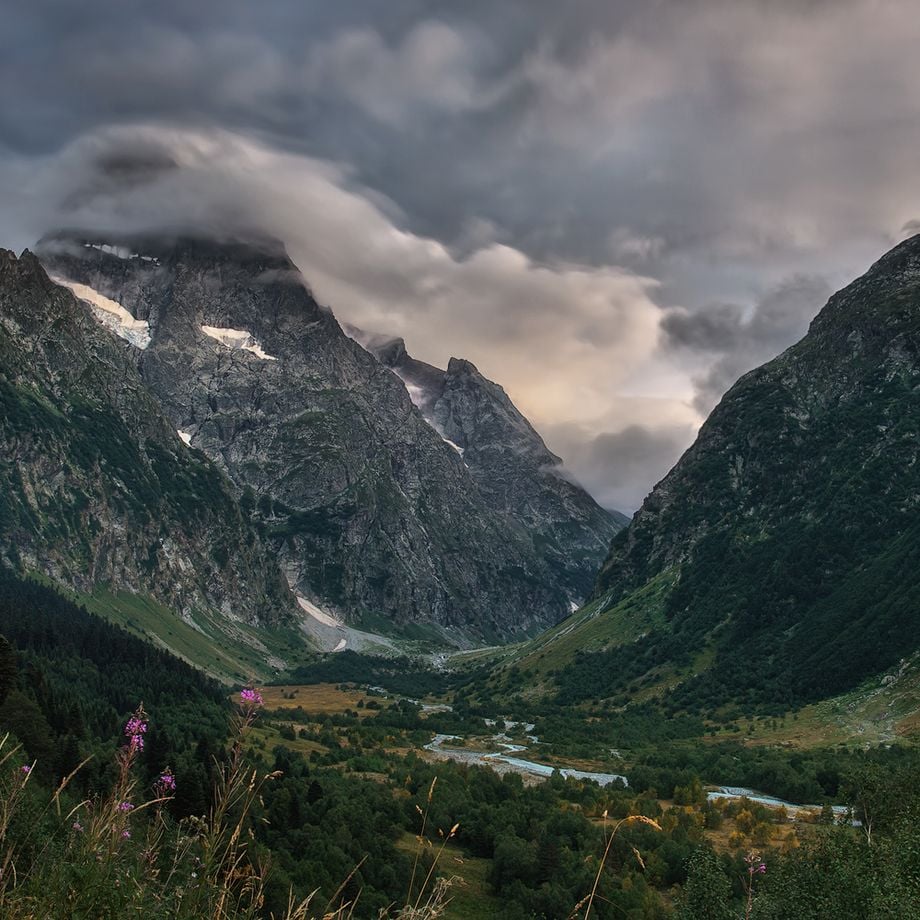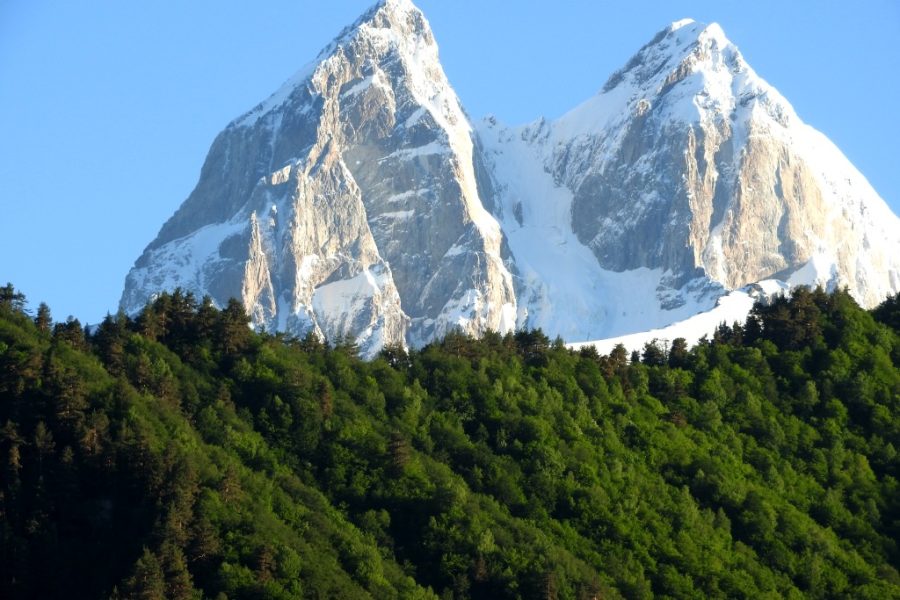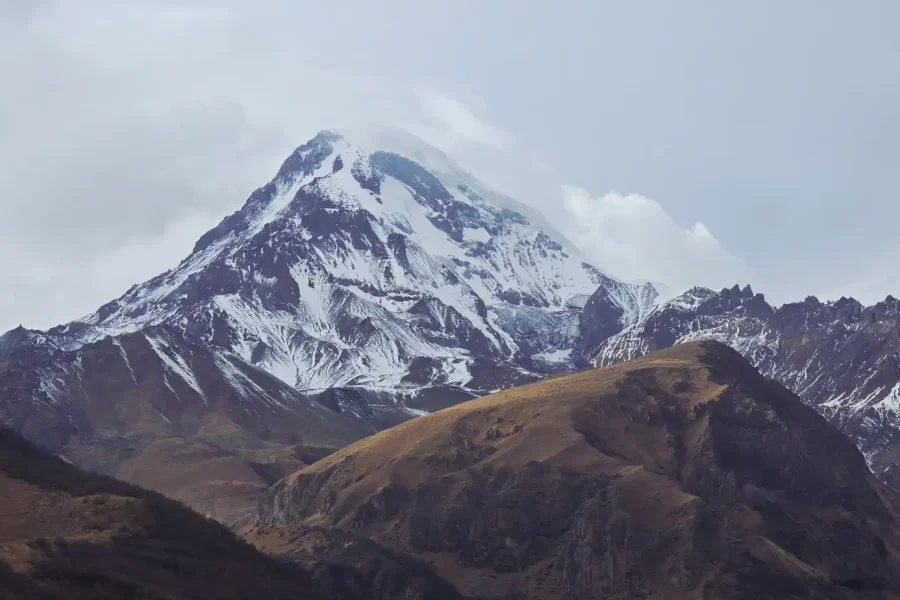Pskhu-Gumista State Nature Reserve: A Vast Occupied Wilderness
Pskhu-Gumista State Nature Reserve is one of the largest protected natural areas in Georgia, covering a vast expanse of mountainous wilderness in Abkhazia. Established in 1978, its purpose is to protect the large, relatively untouched ecosystems of the western Greater Caucasus mountains. This includes extensive, dense forests, the headwaters of important rivers like the Gumista and Pskhu, and the diverse plants and animals that live there.
Imagine rugged mountains covered in thick forests, deep river valleys carving through the landscape, and possibly high meadows above the tree line. This is the kind of environment Pskhu-Gumista protects. It’s a remote area, far from major cities, known for its significant biodiversity. The forests are likely dominated by valuable tree species such as Nordmann Fir, Oriental Beech, and Oriental Spruce. These habitats support a range of Caucasus wildlife, potentially including large mammals like Brown Bears, wolves, lynx, chamois, and deer, as well as unique birds and plants, some found only in this region. The reserve also plays a crucial role in protecting the clean water sources of the Gumista and Pskhu rivers. Inside the reserve’s area lies the village of Pskhu, historically known for its isolation.
Important Note on Current Status: Pskhu-Gumista State Nature Reserve is located entirely within Abkhazia, Georgia, which is currently occupied by the Russian Federation. Consequently, the Georgian government and its Agency of Protected Areas do not have effective control over this vast territory (as of April 2025). Georgian authorities cannot manage the reserve, conduct conservation activities or scientific research, or provide any access from Georgian-controlled areas.
Furthermore, Pskhu-Gumista is designated as a “State Nature Reserve” (Strict Nature Reserve – IUCN Category Ia). This is the highest level of protection, meaning the area is primarily intended for scientific research and the strict preservation of nature with minimal human disturbance. General public access for tourism or recreation is typically prohibited in such reserves, even under normal circumstances, due to the focus on conservation.
Therefore, any information regarding current management, conservation status, rules, or access within Pskhu-Gumista is handled by the de facto authorities controlling Abkhazia, not by official Georgian bodies. No visitor information, including how to get there, facilities, or activities, can be provided or verified by Georgian authorities, both because of the occupation and the reserve’s strict protection status. Access from Georgian-controlled territory is blocked by the occupation line.
Pskhu-Gumista State Nature Reserve represents a significant area of protected Caucasus wilderness under Georgian law. Its large size and remote location make it ecologically vital. However, the ongoing occupation poses serious challenges to its effective protection, management, and study by the responsible Georgian institutions.
Basic Identification
Official Name:
Pskhu-Gumista State Nature Reserve (ფსხუ-გუმისთის სახელმწიფო ნაკრძალი).
Type of Protected Area:
State Nature Reserve (Strict Nature Reserve – IUCN Category Ia). Emphasizes strict conservation and scientific research; public access is generally prohibited.
Date Established:
1978.
Governing Body:
De jure (by law), the Agency of Protected Areas (APA) of Georgia. De facto (in reality), due to the Russian occupation of Abkhazia, the APA cannot exercise control or management. Management is by the de facto authorities in Abkhazia.
Location & Accessibility
Geographic Location:
Georgia, Autonomous Republic of Abkhazia (currently occupied by Russia). Historically within Sukhumi and Gudauta Municipalities. Located in the mountainous interior on the southern slopes of the Greater Caucasus, encompassing the upper basins of the Gumista and Pskhu rivers.
Map/Coordinates:
Approximate central coordinates might be around 43°15′ N, 41°00′ E. Accurate maps and boundary details under Georgian authority may be outdated or unverifiable.
Nearest Cities/Towns:
Sukhumi (capital of occupied Abkhazia) lies to the south. The remote village of Pskhu is located within or near the reserve.
How to Get There:
Access from Georgian-controlled territory is currently impossible due to the occupation line. Access to this remote mountain reserve, even from within Abkhazia, is likely very difficult and would require permission from de facto authorities and possibly special transport (like helicopters to Pskhu). No access information is available via Georgian authorities.
Size & Physical Description
Area:
Approximately 40,818 hectares (408.18 km²). It is a very large reserve.
Topography:
Highly mountainous terrain characteristic of the Greater Caucasus southern slopes. Includes deep river valleys, high ridges, vast forested areas, and likely subalpine and alpine zones at higher elevations. Significant altitude variation.
Geology & Key Features:
Caucasus mountain geology, likely including limestone formations with potential for karst features (caves) and deep river gorges. Large expanses of relatively undisturbed forest are a key feature.
Hydrology:
The reserve covers the headwaters and upper basins of the Gumista River and Pskhu River systems, including numerous tributaries and mountain streams.
Climate:
Mountain climate, with conditions varying greatly depending on altitude. Likely humid due to Black Sea influence, with significant precipitation and heavy snowfall in winter, limiting accessibility.
Purpose & Significance
Reason for Designation:
To ensure the strict protection of large, relatively undisturbed natural ecosystems of the western Greater Caucasus mountains, including extensive virgin forests (particularly fir and beech), associated biodiversity, and the headwaters of the Gumista and Pskhu rivers.
Key Values:
- Conservation: Protects a large area of intact Caucasus mountain wilderness and biodiversity, including endemic species.
- Scientific: Holds significant potential for scientific research on pristine ecosystems (currently inaccessible to Georgian researchers).
- Ecological: Crucial for watershed protection and maintaining ecological balance in the region.
International Recognition:
Located within the Caucasus biodiversity hotspot. Any inclusion in international networks like the Emerald Network under Georgian designation is currently suspended/unverifiable due to occupation.
Biodiversity (Flora & Fauna)
Ecosystems/Habitats:
Predominantly mountain forests (Nordmann Fir, Oriental Beech, Oriental Spruce dominating different belts), possibly with Hornbeam, Oak, and Chestnut forests at lower reachable altitudes. Subalpine scrub and tall herbs, and alpine meadows at higher elevations. Riverine ecosystems along the Gumista, Pskhu, and tributaries.
Key Plant Species:
Key forest-forming trees are Nordmann Fir (Abies nordmanniana), Oriental Beech (Fagus orientalis), and Oriental Spruce (Picea orientalis). The area likely hosts a rich diversity of Caucasus flora, including endemic species. Relict species like Yew or Boxwood might be present.
Key Animal Species:
Expected fauna includes large mammals like Brown Bear, Wolf, Lynx, Chamois, Roe Deer, Wild Boar, and possibly West Caucasian Tur. Rich birdlife includes Caucasus specialties like Caucasian Black Grouse and Caucasian Snowcock, as well as various raptors and forest birds.
Endangered/Rare Species:
Species like Brown Bear and Lynx are protected under Georgian law. West Caucasian Tur (if present) is also of conservation concern. The reserve likely harbors other rare or endemic species typical of undisturbed Caucasus ecosystems. Their current status is unknown to the APA.
Visitor Information
Visitor Center(s):
None. As a Strict Nature Reserve in an occupied territory, there are no visitor facilities managed by Georgian authorities.
Opening Hours & Seasons:
Not applicable for public access under Georgian jurisdiction.
Entrance Fees & Permits:
Not applicable for public access under Georgian jurisdiction. Access requires specific permits, likely scientific, which cannot currently be issued or regulated by the APA for this area.
Trails & Routes:
No marked public trails. It is a wilderness area with very limited infrastructure.
Activities:
Public recreational activities are prohibited according to its Strict Nature Reserve status.
Accommodation:
None within the reserve. The isolated village of Pskhu exists within the area, but no standard tourist accommodation information is available via Georgian authorities.
Facilities:
None for public use (toilets, picnic spots, etc.).
Safety Advice:
Not applicable for the general public due to prohibited access from Georgian-controlled territory and the reserve’s strict status.
Rules & Regulations
Code of Conduct:
Intended rules for authorized (scientific) personnel would be extremely strict, focusing on zero impact.
Prohibitions:
All public access is prohibited. All activities that disturb the natural environment (hunting, logging, fishing, camping, fires, construction, plant/animal collection) are forbidden by the intended reserve regulations.
Zoning:
The entire area operates under a single strict protection zone (IUCN Category Ia).
Current Enforcement:
Georgian authorities cannot enforce any rules or regulations. Enforcement, if any, is by the de facto Abkhaz authorities.
Conservation & Management
Management Authority:
Legally, the Agency of Protected Areas of Georgia. In practice, no management is possible by the APA due to the occupation. Management falls under the de facto Abkhaz authorities.
Conservation Efforts:
No conservation projects can be implemented or monitored by Georgian institutions. The current state of conservation is unknown from the Georgian perspective.
Threats/Challenges:
The primary challenge is the Russian occupation, preventing legal management and protection. Potential threats include lack of effective monitoring and patrolling over a vast remote area, risk of poaching and illegal logging, and potential impacts from any unregulated activities or climate change.
History & Culture
Brief History:
The reserve was established in 1978. The area it encompasses, including the Pskhu valley, has a longer history involving local populations and historical settlements, such as the unique Pskhu village (known for settlements of Russians and Estonians in the past).
Cultural Significance:
The reserve itself is primarily of natural significance. However, the remote Pskhu village has distinct cultural and historical interest due to its isolation and settlement history. Archaeological sites may exist but remain largely unstudied by Georgian institutions in recent decades.
Unique Features/Interesting Facts
- It is one of the largest State Nature Reserves legally designated within Georgia’s territory.
- Protects a huge area of remote, relatively untouched Caucasus wilderness.
- Includes the isolated, high-mountain village of Pskhu.
- Critical for protecting the headwaters of the Gumista and Pskhu rivers.
- Its location within Russian-occupied Abkhazia defines its current inaccessible status from Georgian-controlled territory.





Leave a review